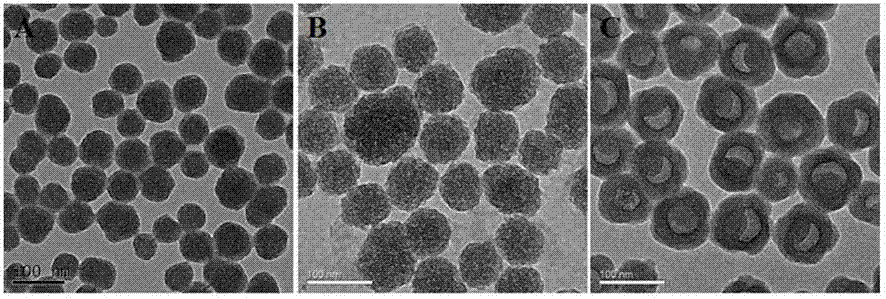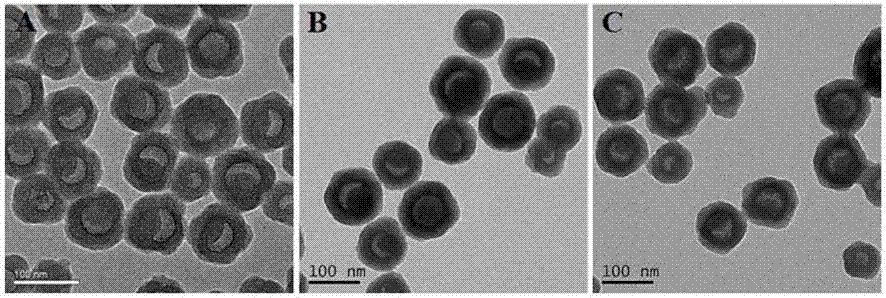Preparation method of degradable silicon dioxide particle internally doped with polyphenol-metal mesh
A silica and mesh technology, applied in the field of preparation of silica nanoparticles, can solve the problems of DNA damage, protein denaturation, dose accumulation, etc., and achieve the effects of uniform size, increased porosity, and simple preparation process
- Summary
- Abstract
- Description
- Claims
- Application Information
AI Technical Summary
Problems solved by technology
Method used
Image
Examples
Embodiment 1
[0037] A method for preparing degradable silica nanoparticles internally doped with a polyphenol-metal complex network structure, comprising the steps of:
[0038] SiO 2 -EGCG-Fe
[0039] a) Add 430 μL TEOS and 8.66 mg EGCG (8.66% doped mass ratio) into ethanol-water solution with a volume ratio of 60:1, stir for 10 min to mix well; add 0.5 mL ammonia water dropwise, Reacted at 25°C for 0.5 h to obtain primary SiO containing polyphenol oligomers 2 .
[0040] b) Then add 1.01mg FeCl 3· 6H 2 O (the molar ratio is EGCG:Fe=5:1), continue to react in a water bath at 25°C for 5.5 h, after the reaction is complete. The reaction solution was taken out and placed in a centrifuge tube, centrifuged at 10,000 rpm for 10 min, the supernatant was taken out, the precipitate was washed twice with absolute ethanol, and then washed twice with ultrapure water, and the precipitate was dispersed in 10 mL twice distilled water to obtain the mixed Degradable silica nanoparticles mixed with EGC...
Embodiment 2
[0043] With TA as doped polyphenol molecules, Fe 3+ As metal ions, the effect of polyphenol doping ratio on the morphology and monodispersity of composite particles was investigated.
[0044] More specifically: SiO 2 -TA-Fe
[0045] a) Add 430 μL TEOS and 8.66 mg TA (doping mass ratio is 8.66%) to the ethanol-water solution with a volume ratio of 60:1, stir for 10 min to mix well; add 0.5 mL ammonia water dropwise, and Reacted at 25°C for 0.5 h to obtain primary SiO containing polyphenol oligomers 2 .
[0046] b) Then add 0.27 mg FeCl 3· 6H 2 O (the molar ratio is TA:Fe=5:1), continue to react in a water bath at 25°C for 5.5 h, after the reaction is completed. The reaction solution was taken out and placed in a centrifuge tube, centrifuged at 10,000 rpm for 10 min, the supernatant was taken out, the precipitate was washed twice with absolute ethanol, and then washed twice with ultrapure water, and the precipitate was dispersed in 10 mL double distilled water to obtain D...
Embodiment 3
[0049] The polyphenol molecules were fixed to ensure that the molar ratio of polyphenols to metal ions was 5:1, and the effects of different doped metal ions on the composite particles were investigated.
[0050] More specifically: SiO 2 -TA-Mn
[0051] a) Add 430 μL TEOS and 12 mg TA (12% doping ratio) into ethanol-water solution with a volume ratio of 60:1, stir for 10 min to mix well; add 0.5 mL of ammonia water dropwise, at 25 After reacting at ℃ for 0.5 h, primary SiO containing polyphenol oligomers was obtained 2 .
[0052] b) Then add 0.28 mg MnCl 2· 4H 2 O (the molar ratio is TA:Mn=5:1), continue to react in a water bath at 25°C for 5.5 h, after the reaction is completed. The reaction solution was taken out and placed in a centrifuge tube, centrifuged at 10,000 rpm for 10 min, the supernatant was taken out, the precipitate was washed twice with absolute ethanol, and then washed twice with ultrapure water, and the precipitate was dispersed in 10 mL double distilled...
PUM
| Property | Measurement | Unit |
|---|---|---|
| Particle size | aaaaa | aaaaa |
Abstract
Description
Claims
Application Information
 Login to View More
Login to View More - R&D
- Intellectual Property
- Life Sciences
- Materials
- Tech Scout
- Unparalleled Data Quality
- Higher Quality Content
- 60% Fewer Hallucinations
Browse by: Latest US Patents, China's latest patents, Technical Efficacy Thesaurus, Application Domain, Technology Topic, Popular Technical Reports.
© 2025 PatSnap. All rights reserved.Legal|Privacy policy|Modern Slavery Act Transparency Statement|Sitemap|About US| Contact US: help@patsnap.com



